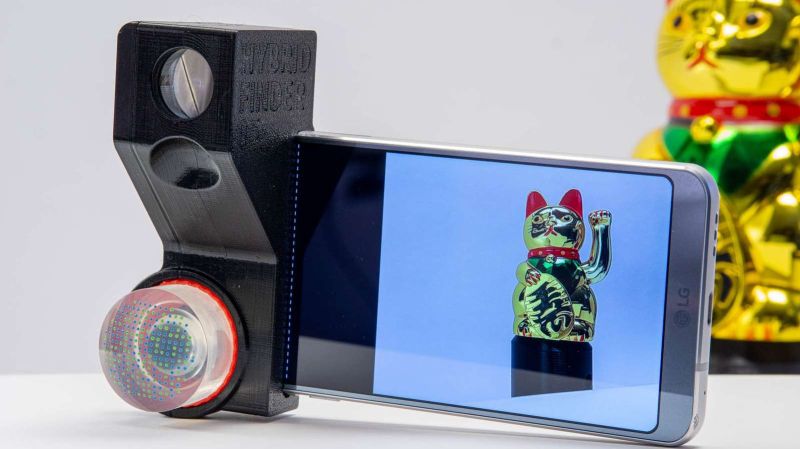Fair warning: if you ever thought there was nothing particularly interesting with optical viewfinders, prepare to have your misconception corrected by [volzo] with this deep-dive into camera-aiming aids that leads to an interesting hybrid smartphone viewfinder.
For most of us, the traditional optical viewfinder is very much a thing of the past, having been supplanted by digital cameras and LCD displays. But some people still want to frame a photograph the old-fashioned way, and the optical principles that make that possible are actually a lot more complicated than they seem. [volzo]’s blog post and video go into a great deal of detail on viewfinder optics, so feel free to fall down that rabbit hole — it’s worth the trip. But if you’d rather cut to the chase, the actual viewfinder build starts at about the 23:00 mark in the video.
The design is an interesting combination of lenses and beamsplitters that live in a 3D-printed enclosure. The whole thing slips over one end of a smartphone and combines an optical view of the scene that corresponds to the camera’s field of view with a small digital overlay from the phone’s screen. The overlay is quite simple: just some framing gridlines and a tilt indicator that’s generated by a little Android app. But it’s clear that much more information could be added now that [volzo] has all the optical issues sorted out.
We appreciate this deep dive into something that appears to be mundane and outdated, which actually proves to be non-obvious and pretty interesting. And if you have any doubt about the extreme cleverness of the camera engineers of yore, look no further than this sort-of solar-powered camera from the 1960s.
















I remember my uncle’s fancy camera with two lenses, one just for the view finder. Whew, twice the cost.
What every phone camera needs that is worth 3D printing is a 2 hands on 2 handles with a button to shoot in the handle that would clip on to your phone. Videos would be watchable without stabilizing.
A separate lens for viewfinding does not necessarily double the price of the camera. The cheapest cameras rely on a separate viewfinder. Removing the need for looking through the lens removes complicated mechanisms such as the reflex mirror (which needs to swing away) and pentaprism. Although, Fancy rangefinders had a cam system that would show the changing FOV based upon focal distance.
If you are not talking about a rangefinder style camera, then the ‘twin lens reflex’ like a ‘— flex’ might be what you remember. Those are usually medium format and therefore it is a MUCH cheaper design than a Hasselblad because you don’t have a 6cm x6cm mirror that has to quickly swing away to expose the shutter to the path of the light. In addition, the secondary optics don’t need to have the same resolving ability as the primary lens either because you are looking at it projected on frosted glass. Double the lens definitely does not equal double the cost.
There are other advantages to a separate viewfinder. Camera’s with a swing away mirror often suffer from ‘mirror slap’ which is vibration induced in the photograph from the mirror’s movement shaking the camera. There are some shutter speeds that are practically unusable because of this effect. Using ‘mirror lock up’ to move the mirror before the shot remedies this, but then you can’t see what your photographing. With a rangefinder design or twin lens reflex you can see what you are photographing even while taking the photo.
Twin lens reflex (TLR) cameras were common before the invention if the inverting prism used in single lens reflex (SLR) ones. Although you had to look down from the top of the camera to frame and focus, this actually had benefits for picture composition since the image was much more like the flat picture the image would eventually become when printed.
Unlike the main lens, which was high quality, coated to reduce chromatic aberrations, and often composite (multiple lenses sandwiched together), the upper focussing/framing lens was a single piece of uncorrected glass, so it didn’t really add much to the cost.
Very interesting indeed !
I really can’t use a screen to aim at a picture, except when on tripod in the studio, without light reflecting on it.
And it’s better for framing not to have anything else to concentrate than the image.
This all very clever, but there is a major problem: adding this gizmo negates the benefits of having a slim camera always in your pocket ready to shoot. If you start adding bulk to a phone in order to improve the shooting experience, then you are better off just buying a real camera. You’ll get better optics, a much bigger better sensor, and real ergonomics and UI meant for capturing images. I love having a decent camera phone in my pocket all the time for impromptu moments. But I also love my Ricoh GRiii, let alone my Fuji mirrorless kit. Given the choice, I would take photos on the Ricoh any day over any camera phone on the market, no matter how many viewfinder and shutter grip attachments you add to it.